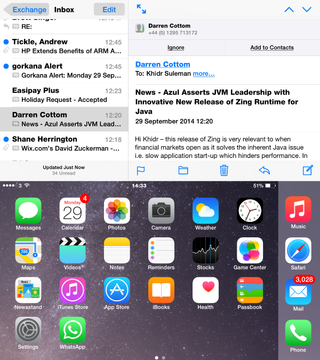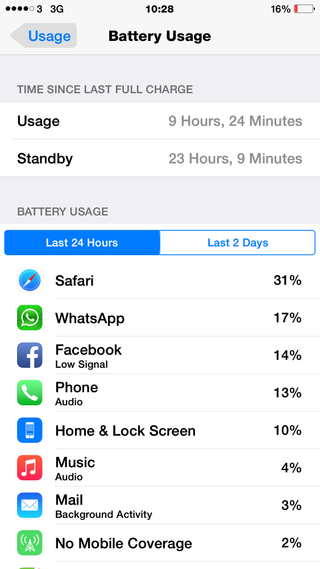IT Pro Verdict
The iPhablet has a superb set of specifications with the display and battery life being the stand out features.
Pros
- +
Great screen; Dedicated landscape mode; Solid battery life; Fantastic all-round camera
Cons
- -
Too big for some; No stylus; Expensive
Apple belatedly entered the phablet' market with a mammoth 5.5in device in 2014. While the iPhone 6 Plus has superior specifications to the smaller iPhone 6 - does it translate to a better user experience? We take a look at the good and the bad
Best features
Display
There are no questions as to why DisplayMate labelled this iPhone as the best LCD panel on the market when it was released. This is because it was the first iPhone with a full HD 1920 x 1080 resolution (401ppi). Text and images appear pin sharp on this display with natural colour replication and abaolutely superb viewing angles. The 6 Plus also impressed us when we were watching videos from the iTunes store as the 16:9 aspect ratio makes black bars obsolete.

The extra screen space is taken advantage of through the new beefed up landscape mode. Some apps provide two-pane views, sich as Mail and Notes, and you can even use undo, copy and paste which pop up on the default keyboard in this view.
The home screen can even use landscape view which means you can use the device exclusively in this mode just like a tablet. (Note: You won't be able to use the home screen in landscape mode if you switch to Zoomed Mode to make the icons larger)

We managed to measure a maximum brightness of 500 cd/m2 on the iPhone 6 plus. We were also able to reduce the brightness between 25% to 50% and still see everything on the screen comfortably. The only time when you will have to raise the brightness levels is when watching video or if you have to combat sunlight.
Best battery life of any iPhone
The iPhone 6 Plus ended the problem that iPhone 5/5s users had where they needed to charge their device in the middle of the day. Its big chassis is home to a 2915mAh battery pack which is almost twice the size of the 5s's.
Remarkably, this is the first iPhone we've been able to use without having to worry too much about the battery life. After a huge 23 hours from the mains we still had 16 per cent battery left.

Battery life will depend on how much you use the device - so if you load up lots of data hungry apps don't be surprised to see it drain quickly. However, another positive is the ability to charge the 6 Plus faster than previous models using the iPad adaptor. This should get to 90 per cent after two hours. Even charging the device from USB port on a MacBook Pro was swift. We managed to get to 47 per cent in 60 minutes.
Touch ID
This retains its position as the best fingerprint scanner we've tested on any device thanks to its simplicity and convenience.
Competitor handsets like the Galaxy S5 require you to swipe to activate the fingerprint scanner - but with Touch ID all you have to do is touch the home button. And because this is a natural way to wake iPhones, you can unlock devices with one action.

With Apple opening up the APIs to third-parties, Touch ID has become ever more useful as you can log into things like your Amazon account.
Excellent camera
The 8-megapixel camera uses the same sensor as the iPhone 6 but Apple has also included Optical Image Stabilisation. It's the inclusion of the Focus Pixels technology and the low-light performance, which helps this to stand out from other devices.
The 6 Plus focuses so quickly that you can snap away multiple pictures without worrying about focusing. During an event at the Electric Ballroom, we took some quick fire shots without tapping the screen to focus and they turned out perfectly.

What the deal with Bendgate?
Despite Bendgate trending on social media after pictures of misshapen iPhones appeared, the issue seems to have been exaggerated.Apple says only 9 customers have officially complained regarding bending of the iPhone 6 Plus - and out of the millions of shipped devices, this is insignificant.
According to Consumer Reports, the iPhone 6 Plus is structurally sound. Tests show it is capable of withstanding more pressure than the iPhone 6. Under normal usage, there should be no problems.
iOS 8
iOS 8.0.2 has been rushed out and we haven't experienced any major bugs so far. Apple has also fixed the bug with HealthKit - so health monitoring apps should be flooding the App Store soon.
The latest update brings a wealth of options including the ability to customise the keyboard, have more control over privacy, better web browsing and MDM controls for businesses.
Areas for improvement
Just too big
It would have been interesting to see if the 6 Plus would have made it to market if Steve Jobs was still in charge at Apple as he loathed big screen handsets.
Although we loved the big screen for web browsing and watching videos, the dimensions of the device made it unwieldy. Interestingly, the 6 Plus is longer than the Galaxy Note 4, despite the latter having a bigger 5.7in display.
The device slips snuggly into most trousers without any problem but it will protrude from cardigans and the pockets of smaller jackets.

Like most phablets, the 6 Plus will also make you feel self-conscious when holding it to your ear in public. This can be avoided by using the headphones to make calls. You will get used to the size with usage, but if your hands are small this could cause discomfort.
No Stylus
It's a shame Apple doesn't offer a stylus as this can increase the usefulness of the device for graphical work and make it easier to use with one hand.
Fear of the drop
While the iPhone 6 is highly unlikely to bend in your pocket, questions remain about how fragile the device is. Even with a cover, the results of a drop test are unlikely to be positive.
1GB RAM
The 6 Plus is loaded up with a snappy A8 processor, but Apple continues to use just 1GB of RAM. That's three times less than devices like Galaxy Note 4 and Xperia Z3.
It poses questions about how the iPhone 6 Plus will be able to handle upgrades. We've already seen the 4s struggle to run the iOS 8 and with apps demanding ever more resources, the shelf life of the 6 Plus is questionable beyond 12 months.
Value for money?
It's not cheap. The 6 Plus starts at 619 SIM-free (16GB). This rises to 699 for the 64GB model and 789 for 128GB of internal storage.
Contracts pricing is also at the high-end. The 16GB model costs 230 upfront with a monthly charge of 33 (24 months). This comes with 1GB of data, unlimited minutes and texts.
Overall - Is it better than the iPhone 6?
This is Apple's first-generation phablet so there's room for improvement. Although the 6 Plus has a superb display and great battery life, we found it too cumbersome for everyday usage.
At 4.7ins the iPhone 6 has a manageable size, the same processor/1GB RAM and almost identical camera. But with better battery life and screen, we'd opt for the 6 Plus if you don't mind the bulk.
Zach Marzouk is a former ITPro, CloudPro, and ChannelPro staff writer, covering topics like security, privacy, worker rights, and startups, primarily in the Asia Pacific and the US regions. Zach joined ITPro in 2017 where he was introduced to the world of B2B technology as a junior staff writer, before he returned to Argentina in 2018, working in communications and as a copywriter. In 2021, he made his way back to ITPro as a staff writer during the pandemic, before joining the world of freelance in 2022.


